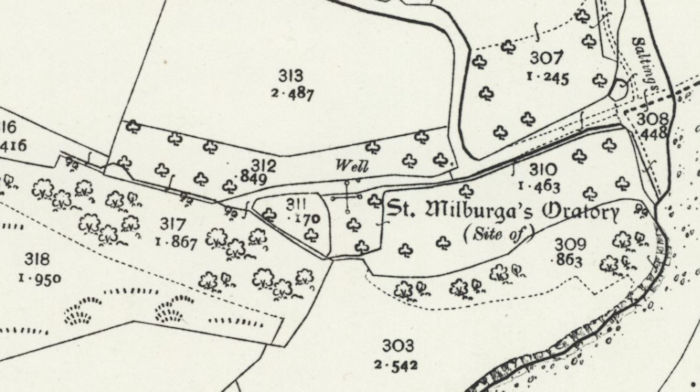 |
Dedication: Saint Milburga? Location: Bridge End Coordinates: 50.30540, -3.85287 Grid reference: SX681466 Heritage designation: none |
 |
Dedication: Saint Milburga? Location: Bridge End Coordinates: 50.30540, -3.85287 Grid reference: SX681466 Heritage designation: none |
The presence of a dedication to a rather minor Shropshire saint in rural Devon is quite mysterious. St Milburga, the daughter of King Merewald of Magonsaete, a sub-kingdom of Mercia, was the abbess of Wenlock Priory during the 8th century; after her relics were supposedly re-discovered in 1101, Much Wenlock became a place of pilgrimage. However, although Milburga was very popular in Shropshire (she was, arguably, the most popular saint in Shropshire), it is unlikely that her fame reached Devon, almost 200 miles from Much Wenlock, and there is no evidence of her cult spreading to anywhere else in England. It is possible that there was an early community of Mercians in Devon, or that a local pilgrim travelled to Much Wenlock, received a "cure" from Milburga's relics (Milburga was renowned for curing the blind), and wished to commemorate her locally. It is also quite plausible that the dedication to Milburga came later, as a corruption of another name.
Regardless of the origins of the dedication, St Milburga's Oratory, as it was known, was certainly associated with the Shropshire saint by the 14th century. According to John Eric Bruce Gover, writing in volume 8 of The Place-Names of Devon, in 1931, the name of the chapel or oratory was recorded in both 1381 and in 1425 as "Capella Sancte Milburge" in the episcopal registers of the Diocese of Exeter. On the 18th of October, 1395, Edmund Stafford, the then bishop of Exeter, noted in his register that he had licensed the chapel to William Poundestoke (the Canon of Exeter and Bigbury's rector). Only a decade or so later, on the 9th of May, 1411, Poundestoke left 13 shillings and 4 pence to the store of "St Milburga"; this was equivalent to roughly £550 in today's money, and, in 1411, was the price of a decent cow. On the 10th of April, 1427, a licence was given "to Sir John Rector of Bykebury to celebrate Divine Service in the Chapel of St. Milburga in his parish" ("Bykebury" being Bigbury), by Bishop Edmund Lacy, who succeeded Edmund Stafford as Bishop of Exeter in 1420, and recorded the giving of this licence in his register. The chapel was, unfortunately, demolished in the late 19th century.
It is clear, then, that the chapel's dedication to St Milburga was solid by the late medieval period. However, there is little evidence that the associated well, which was located just outside the chapel and was certainly used to supply water to it for baptisms, was dedicated to St Milburga as well. The reason that I have included this site on this website is that the Historic Environment Record for Devon records it as "St Milburga's Well". It is, of course, extremely likely that the well bore the name of St Milburga, simply because of its proximity to the chapel, but there is almost no solid evidence to support it. William White, in 1879, in his History, Gazetteer and Directory of the County of Devon, mentioned the site briefly without ascribing any particular interest to it:
|
At Milburgh [this was the name of the place in the 19th century; other forms recorded at that time include "Milborough"] was an oratory near a spring. |
Historically, the well has almost always been marked on Ordnance Survey maps, excepting just a few that were not detailed enough to include it. Today, the well is still marked, and presumably still exists, although its exact condition is currently unrecorded.
|
Access: The well is located on private land in the garden of a house, from which permission is to be obtained. |
Copyright 2025 britishholywells.co.uk